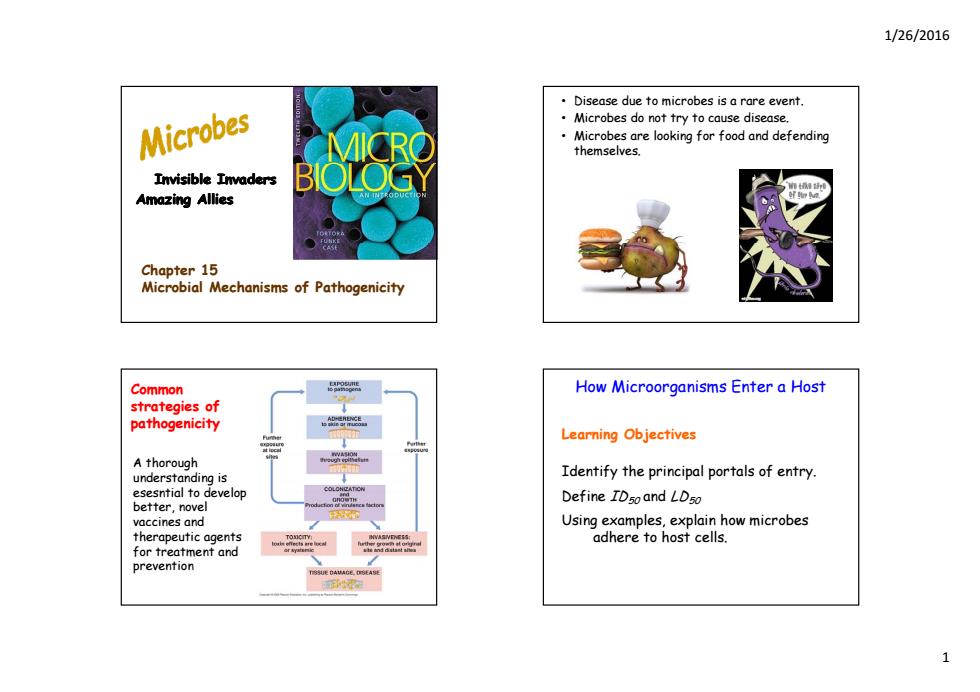
1/26/2016 Disease due to microbes is a rare event. Microbes Microbes do not try to cause disease. Microbes are looking for food and defending themselves. Invisible Invaders Amazing Allies Chapter 15 Microbial Mechanisms of Pathogenicity Common How Microorganisms Enter a Host strategies of pathogenicity Learning Objectives A thorough understanding is Identify the principal portals of entry. esesntial to develop Define IDso and LDso better,novel vaccines and Using examples,explain how microbes therapeutic agents adhere to host cells. for treatment and prevention
1/26/2016 1 Invisible Invaders Amazing Allies Chapter 15 Microbial Mechanisms of Pathogenicity • Disease due to microbes is a rare event. • Microbes do not try to cause disease. • Microbes are looking for food and defending themselves. Common strategies of pathogenicity A thorough understanding is esesntial to develop better, novel vaccin n es a d therapeutic agents for treatment and prevention How Microorganisms Enter a Host Learning Objectives Identify the principal portals of entry. Define ID50 and LD50 Using p,p examples, explain how microbes adhere to host cells
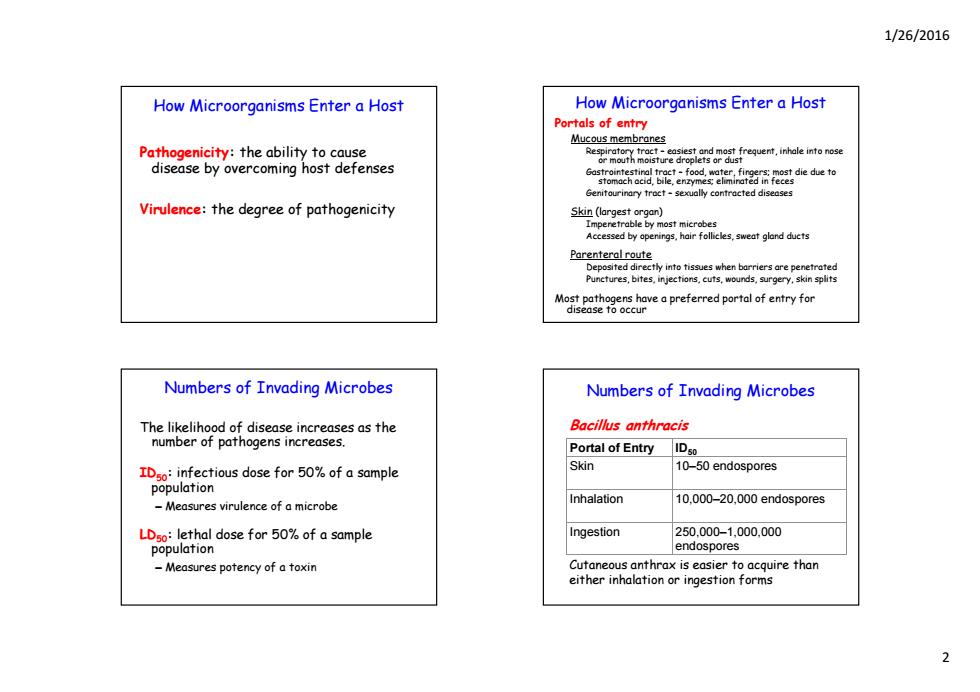
1/26/2016 How Microorganisms Enter a Host How Microorganisms Enter a Host Portals of entry Mucous membranes Pathogenicity:the ability to cause disease by overcoming host defenses dedie due to Genitourinary troct-sexually contracted diseases Virulence:the degree of pathogenicity by most microbes Parenteral route Most pathogens have a preferred portal of entry for disease to occur Numbers of Invading Microbes Numbers of Invading Microbes The likelihood of disease increases as the Bacillus anthracis number of pathogens increases. Portal of Entry IDso ID:infectious dose for 50%of a sample Skin 10-50 endospores population Inhalation Measures virulence of a microbe 10.000-20,000 endospores LDso:lethal dose for 50%of a sample Ingestion 250.000-1,000,.000 population endospores Measures potency of a toxin Cutaneous anthrax is easier to acquire than either inhalation or ingestion forms
1/26/2016 2 How Microorganisms Enter a Host Pathogenicity: the ability to cause di b i h t d f disease by overcoming host defenses Virulence: the degree of pathogenicity How Microorganisms Enter a Host Portals of entry Mucous membranes Respiratory tract – easiest and most frequent, inhale into nose or mouth moisture droplets or dust Gastrointestinal tract – food, water, fingers; most die due to stomach acid, bile, enzymes; eliminated in feces Genitourinary tract – sexually contracted diseases Skin (largest organ) Impenetrable by most microbes Accessed by openings, hair follicles, sweat gland ducts Parenteral route Deposited directly into tissues when barriers are penetrated Punctures, bites, injections, cuts, wounds, surgery, skin splits Most pathogens have a preferred portal of entry for disease to occur Numbers of Invading Microbes The likelihood of disease increases as the number of p g atho ens increases. ID50: infectious dose for 50% of a sample population – Measures virulence of a microbe LD50: lethal dose for 50% of a sample population – Measures potency of a toxin Portal of Entry ID Numbers of Invading Microbes Bacillus anthracis Portal of Entry ID50 Skin 10–50 endospores Inhalation 10,000–20,000 endospores Ingestion 250,000–1,000,000 endospores Cutaneous anthrax is easier to acquire than either inhalation or ingestion forms
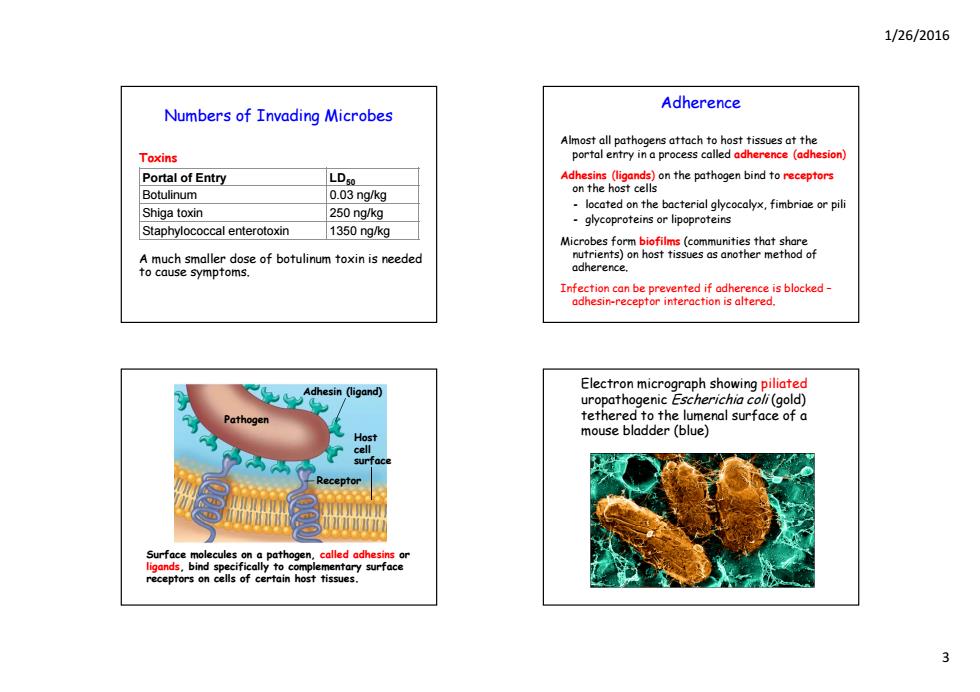
1/26/2016 Adherence Numbers of Invading Microbes Almost all pathogens attach to host tissues at the Toxins portal entry in a process called adherence (adhesion) Portal of Entry LD50 Botulinum 0.03 ng/kg located on the bacterial glycocalyx,fimbriae or pili Shiga toxin 250 ng/kg glycoproteins or lipoproteins Staphylococcal enterotoxin 1350 ng/kg Microbes form biofilms(communities that share much smaller dose of botulinum toxinis neede nutrients)on host tissues as another method of cause symptoms adherence. Infection can be prevented if adherence is blocked- adhesin-receptor interaction is altered. Adhesin (ligand) Electron micrograph showing piliated uropathogenic Escherichia coli(gold) Pathogen tethered to the lumenal surface of a mouse bladder (blue) Surface molecules on a pathogen.called adhesins or ligands.bind specifically to complementary surface receptors on cells of certain host tissues
1/26/2016 3 Numbers of Invading Microbes Toxins Portal of Entry LD50 Botulinum 0.03 ng/kg Shiga toxin 250 ng/kg Staphylococcal enterotoxin 1350 ng/kg A much smaller dose of botulinum toxin is needed to cause symptoms. Adherence Almost all pathogens attach to host tissues at the portal entry in a process called adherence (adhesion) Adhesins (ligands) on the pathogen bind to receptors on the host cells - located on the bacterial glycocalyx, fimbriae or pili - glycoproteins or lipoproteins Microbes form biofilms (communities that share nutrients) on host tissues as another method of adherence. Infection can be prevented if adherence is blocked – adhesin-receptor interaction is altered. Adhesin (ligand) Pathogen Host cell surface Receptor Surface molecules on a pathogen, called adhesins or ligands, bind specifically to complementary surface receptors on cells of certain host tissues. Electron micrograph showing piliated uropathogenic Escherichia coli (gold) tethered to the lumenal surface of a mouse bladder (blue)
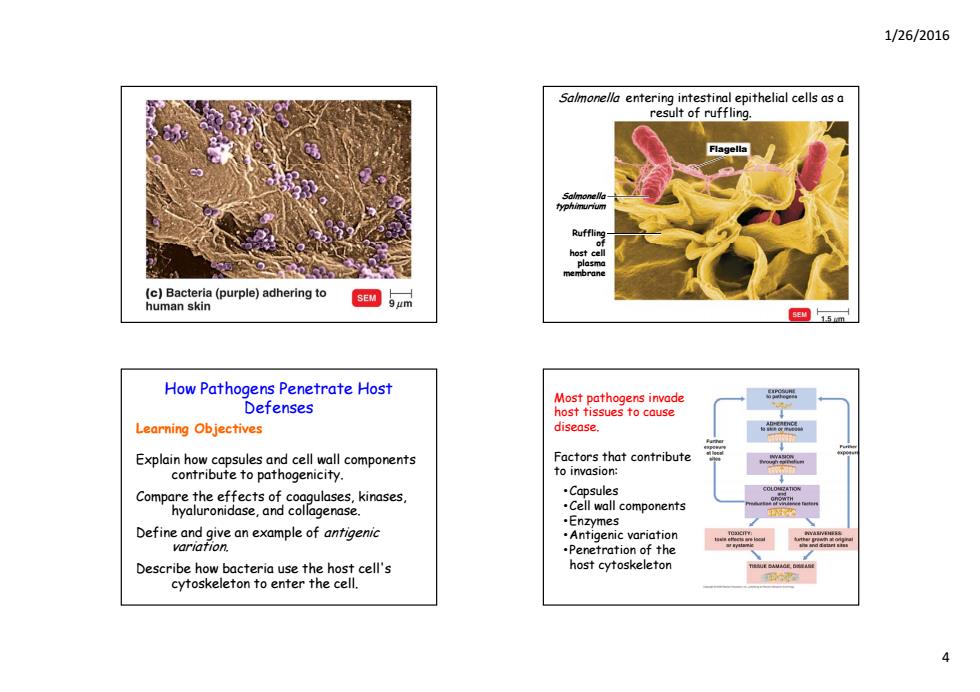
1/26/2016 Salmonella entering intestinal epithelial cells as a result of ruffling. Flagella cel (c)Bacteria(purple)adhering to human skin e15m How Pathogens Penetrate Host Defenses Most pathogens invade host tissues to cause Learning Objectives disease. Explain how capsules and cell wall components Factors that contribute contribute to pathogenicity. to invasion: Compare the effects of coagulases,kinases, .Capsules hyaluronidase,and collagenase .Cell wall components .Enzymes Define and give an example of antigenic Antigenic variation variation. 一 .Penetration of the Describe how bacteria use the host cell's host cytoskeleton cytoskeleton to enter the cell
1/26/2016 4 Flagella Salmonella entering intestinal epithelial cells as a result of ruffling. Salmonella typhimurium Ruffling of host cell plasma membrane How Pathogens Penetrate Host Defenses Learning Objectives Explain how capsules and cell wall components contribute to pathogenicity. Compare the effects of coagulases, kinases, hyaluronidase, and collagenase. Define and give an example of antigenic variation. Describe how bacteria use the host cell's cytoskeleton to enter the cell. Most pathogens invade host tissues to cause disease. Factors that contribute to invasion: •Capsules •Cell wall components •Enzymes •Antigenic variation • Penetration of the host cytoskeleton
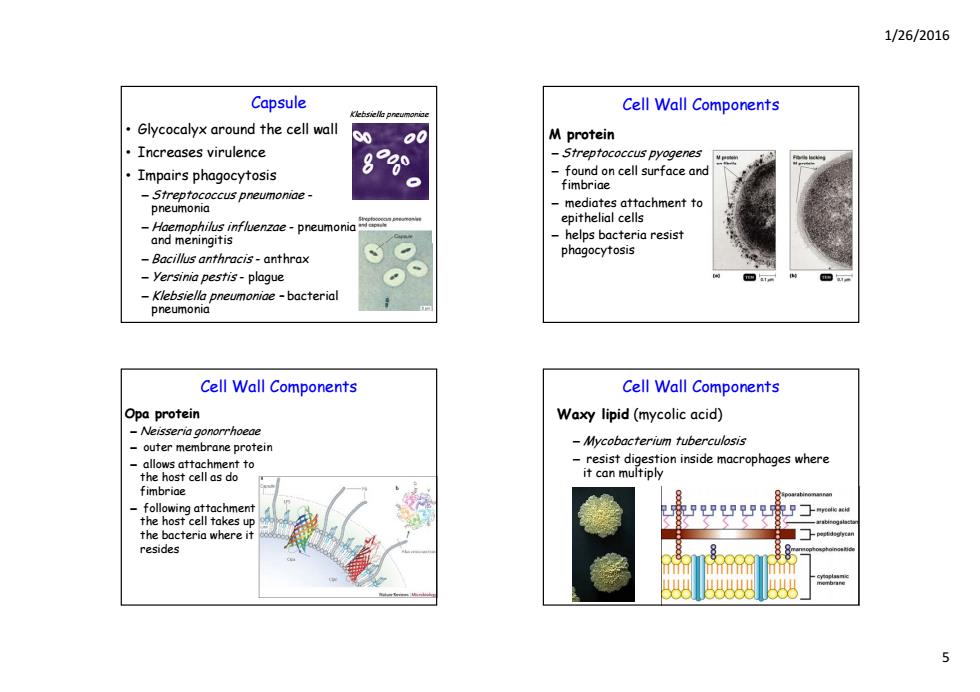
1/26/2016 Capsule Klebsiella pneumoniae Cell Wall Components Glycocalyx around the cell wall o0 M protein ·Increases virulence Streptococcus pyogenes Impairs phagocytosis g found on cell surface and fimbriae Streptococcus pneumoniae- pneumonia mediates attachment to -Haemophilus influenzae-pneumonia epithelial cells and meningitis -helps bacteria resist Bacillus anthracis-anthrax phagocytosis yersinia pestis-plague -Klebsiella pneumoniae -bacterial pneumonia Cell Wall Components Cel‖Wall Components Opa protein Waxy lipid(mycolic acid) -Neisseria gonorrhoeae outer membrane protein -Mycobacterium tuberculosis allows attachment to -resist digestion inside macrophages where the host cell as do it can multiply fimbriae following attachment the host cell takes up the bacteria where it resides
1/26/2016 5 Capsule • Glycocalyx around the cell wall • Increases virulence Klebsiella pneumoniae • Impairs phagocytosis – Streptococcus pneumoniae - pneumonia – Haemophilus influenzae - pneumonia and meningitis – Bacillus anthracis - anthrax – Yersinia pestis - plague – Klebsiella pneumoniae – bacterial pneumonia Cell Wall Components M protein – Streptococcus pyogenes – found on cell surface and fimbriae – mediates attachment to epithelial cells – helps bacteria resist phagocytosis Cell Wall Components Opa protein – Neisseria gonorrhoeae – outer membrane protein – allows attachment to the host cell as do fimbriae – following attachment the host cell takes up the bacteria where it resides Cell Wall Components Waxy lipid (mycolic acid) – Mycobacterium tuberculosis – resist digestion inside macrophages where it can multiply